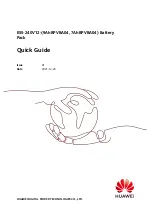
Input Cable
The Duo Charge includes a 30-amp, fused 10-gauge cable with two ring terminals. To install the Input Cable:
Connect the larger of the two ring terminal connections to the positive post of your house battery. Most marine batter-
1.
ies will include a secondary stud on the battery lug that will provide a satisfactory connection point.
Connect the smaller of the two ring terminal connections to the input terminal of the Duo Charge.
2.
While it may be more convenient to mount the Duo Charge a further distance than is allowed by the length of the Input
Cable, we strongly recommend limiting that distance to the length provided. Again, the shorter length of the input wire
allows for a longer run of the output side of the Duo Charge wiring to add greater ability to address larger loads.
ON/OFF Wire
The fourth and final wire required for basic operation is the ON/OFF wire, which supplies either switched or constant power
to the Duo Charge. If automatic activation of the Duo Charge is desired whenever a source of charging is available at the
house battery bank, the ON/OFF wire can be connected directly to the positive post of the house battery or at the Input
terminal of the Duo Charge (as shown in diagram at right).
When connected directly to house battery voltage, the Duo Charge will remain in a sleep mode whenever input voltage
remains below 13 volts in a 12-volt charging system, or 26 volts in a 24-volt charging system. When voltage at the Input
terminal exceeds that voltage threshold, the Duo Charge will provide charging current to the starting battery. When used
in this mode, the Duo Charge will require a nominal amount of current while asleep (approximately 500mA). If the vessel
remains disconnected from a charge source for an extended period, the Duo Charge can be disabled by disconnecting the
ON/OFF wire from the ON/OFF terminal, or by installing and using an ON/OFF toggle in the ON/OFF wire.
If the Duo Charge is only intended for use when the house battery is being charged by
the alternator and regulator, the ON/OFF wire can be connected to the same switched
voltage source that’s used to supply the voltage regulator’s ignition circuit. To install
the ON/OFF wire:
Determine the preferred method for Duo Charge activation, and the preferred
1.
source for ON/OFF voltage.
Provide a length of 14-gauge wire suitable for the intended voltage source and the
2.
Duo Charge.
Attach one appropriately sized ring terminal or other suitable termination connec-
3.
tor, and a 1/4” female spade connector to the ends of the wire.
Plug the 1/4” spade terminal onto the Duo Charge’s ON/OFF connector pin.
4.
Connect the other end of the wire, as required, to the desired source of ON/OFF
5.
voltage.
Optional Wiring Connections
While the Duo Charge does provide full functionality with the basic four-wire connections discussed above, there are a
number of optional functions which may provide additional capacity or intelligence. These include battery temperature
sensing and solenoid control, which enables the manual bypass of the Duo Charge’s internal circuitry and activation of a
solenoid drive circuit that can be used in conjunction with a higher capacity solenoid relay.
3


























